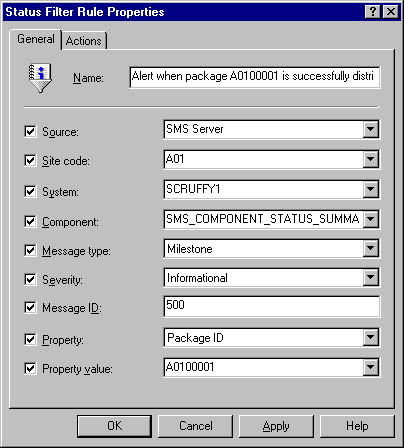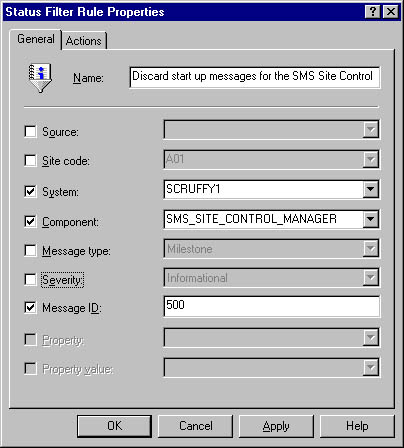Filtering Status Messages
SMS components and site systems generate a constant stream of status messages. Most of these messages will prove to be extremely helpful in resolving issues or troubleshooting problems you may be having with your SMS site. Some messages, however, may simply be flooding the Status Message Viewer with interesting but not particularly useful information, or too much information, or not the kind of information you are looking for.
There are several ways to filter status messages and display just the status information of interest. We looked at one technique in the section "Setting Status Message Viewer Options" earlier in this chapter. Status filtering can also be accomplished in a more global fashion by modifying the status reporting properties or by defining status filter rules.
Configuring Status Reporting Properties
To configure the status reporting component properties, in the SMS Administrator Console, expand the Site Settings folder and then expand the Component Configuration folder. Right-click on Status Reporting and choose Properties from the context menu to display the Status Reporting Properties window, shown in Figure 5-28.

Figure 5-28. The Status Reporting Properties window.
By default, reporting is enabled for both the site server and the client components for the following types of messages:
- All milestones
- All milestones and all details
- Error and warning milestones
- Error milestones
By selecting the appropriate message types from the drop-down lists, you can control how much data is reported. For example, to filter out all milestone messages that are not errors or warnings, select the Error And Warning Milestones option.

CAUTION
The default settings for message reporting are considered appropriate for most SMS sites. Enabling too many messages or filtering out too much information can make the status message system less effective as a problem-solving tool.
The Report Details On Failure option is also selected by default. This powerful feature ensures that when a failure occurs or an error is reported, the affected component reports details as to the nature of the failure as well as possible causes and remedies. You will probably not want to disable this feature—unless, of course, you can troubleshoot without knowing the details of a problem.
You can also enable logging for the same message types to the Windows NT Event Log and include failure details in the log.
Status Filter Rules
The second way to globally affect how status messages are reported is by using status filter rules. SMS creates fifteen status filter rules of its own to control how status messages are reported and viewed, as shown in Figure 5-29. To access this list, in the SMS Administrator Console, expand the Site Settings folder, and then expand the Status Filter Rules folder. These default status filter rules are used to control how many and which status messages are reported and displayed in the Status Message Viewer.

Figure 5-29. The SMS default status filter rules.
When a status message is generated by an SMS component, Status Manager tests the message against these status filter rules to determine how that message should be handled. Status Manager then performs one or more of the following actions:
- Writes the message to the SMS database
- Writes the message to the Windows NT Event Log
- Replicates the message to the parent site
- Sends the message to a status summarizer
- Executes a program
Most of the default status filter rules generate a system message that is displayed on the site server using a NET SEND command. You should not fool around with any of these default status filter rules. Each has been created for a reason, and they are all significantly useful. But you may find that you want to create additional status filter rules. You can customize status filter rules to discard certain types of messages that you don't want or need to see, to replicate certain types of messages to a parent site at a higher priority than others or not replicate certain messages at all, and to execute a program based on a message type.
Begin by deciding just what messages you need to see and what messages you do not need to see. For example, if your site participates in a parent-child relationship but is fully administered within the site—that is, no administration occurs at the parent site—it may be unnecessary to replicate any status messages to the parent site. Eliminating this replication would certainly decrease the amount of network traffic generated between the parent site and your site.

CAUTION
Do not modify existing status filter rules or define any new status filter rules until you are fully comfortable with and knowledgeable about the status message system. If you make a change without knowing its full effect, you could render the status message system useless to you as a troubleshooting tool.
Follow these steps to create a new status filter rule:
- In the SMS Administrator Console, expand the Site Settings folder.
- Right-click on Status Filter Rules, choose New from the context menu, and then choose Status Filter Rule to display the Status Filter Rule Properties window, shown in Figure 5-30.
- On the General tab, enter a descriptive name for your filter.

Figure 5-30. The General tab of the Status Filter Rule Properties window.

TIP
The status filter name should adequately explain the function and purpose of the status filter rule you are creating. Use the default status filter names as a guideline.
- Select the Actions tab, shown in Figure 5-31, and specify what Status Manager should do when the message criteria defined on the General tab are met.
- Click OK to save the new filter rule.
You can narrow your filter criteria further by selecting any combination of options available on the General tab. These options are described in Table 5-1.

Figure 5-31. The Actions tab.
In this example, Status Manager has been instructed to write the message to the SMS database as well as to the Windows NT Event Log. By default, the message will also be forwarded to the appropriate status summarizer to be included in the Status Message Viewer.
Table 5-1. Status filter rule options
| Option | Description |
|---|---|
| Source | The source of the status message: SMS site server, SMS client, or SMS Provider |
| Site Code | The site code corresponding to the source of the status message |
| System | The name of the SMS client or server that generates the status message |
| Component | The name of the SMS component that generates the status message |
| Message Type | The status message type: milestone, detail, or audit |
| Severity | The message severity: informational, warning, or error |
| Message ID | The specific status message ID you are reporting on—for example, an ID of 500 generally relates to a component starting up |
| Property | The name of a specific property, such as Advertisement ID, Package ID, Collection ID, or User Name, that may be present in some status messages you want to report on |
| Property Value | A specific property attribute for the property name you specified, such as Advertisement ID, Package ID, Collection ID, or User Name, that may be present in some status messages you want to report on |
The new status filter rule will be added at the end of the list of existing rules. The order in which the rules are listed is determined by their relative priority. Status messages will be passed through all the filters if you don't select the Do Not Process Lower-Priority Status Filter Rules check box for a filter on the Actions tab. If you do select this option for a filter, the message won't pass through any filters below this one in the filter list. You can change the order of filter processing by right-clicking on a filter, choosing All Tasks from the context menu, and then choosing Increment Priority to move the filter up in the list or Decrement Priority to move the filter down in the list.

TIP
The Run A Program option on the Actions tab can be a useful alert tool if you are using a Microsoft Windows NT_compatible paging application. You can then enter the command-line sequence for executing a page to notify you when a specific status message is generated. Consult Appendix F in the Systems Management Server Administrator's Guide for a more complete discussion of the use of command-line sequences for customized status programs.
![]()
REAL WORLD Using Status Filter RulesChapter 20 of the Systems Management Server Administrator's Guide contains several useful example status filter rules. The status filter rule for discarding status messages from a component that is flooding the system is particularly useful. After you have become comfortable with the status message system and the way in which the various SMS components work and interact, you may want to filter out simple informational messages such as messages generated when a component starts or wakes up. Follow the steps outlined earlier to define this simple filter. On the General tab, specify a name in the form "Discard message xyz from component abc on server 123." Fill in the System, Component, and Message ID fields as shown in Figure 5-32. For this example, we are excluding startup messages for Site Control Manager.

Figure 5-32. Defining a sample status filter rule.
On the Action tab, select the Do Not Forward To Status Summarizers check box. This setting will ensure that the message is disregarded and that it will not be displayed in the Status Message Viewer. Depending on where this new rule sits in relation to the other rules, you may also want to check the Do Not Process Lower-Priority Status Filter Rules check box to prevent any subsequent filters from picking up this message and possibly writing it to the database or displaying it in the Status Message Viewer.
EAN: 2147483647
Pages: 167